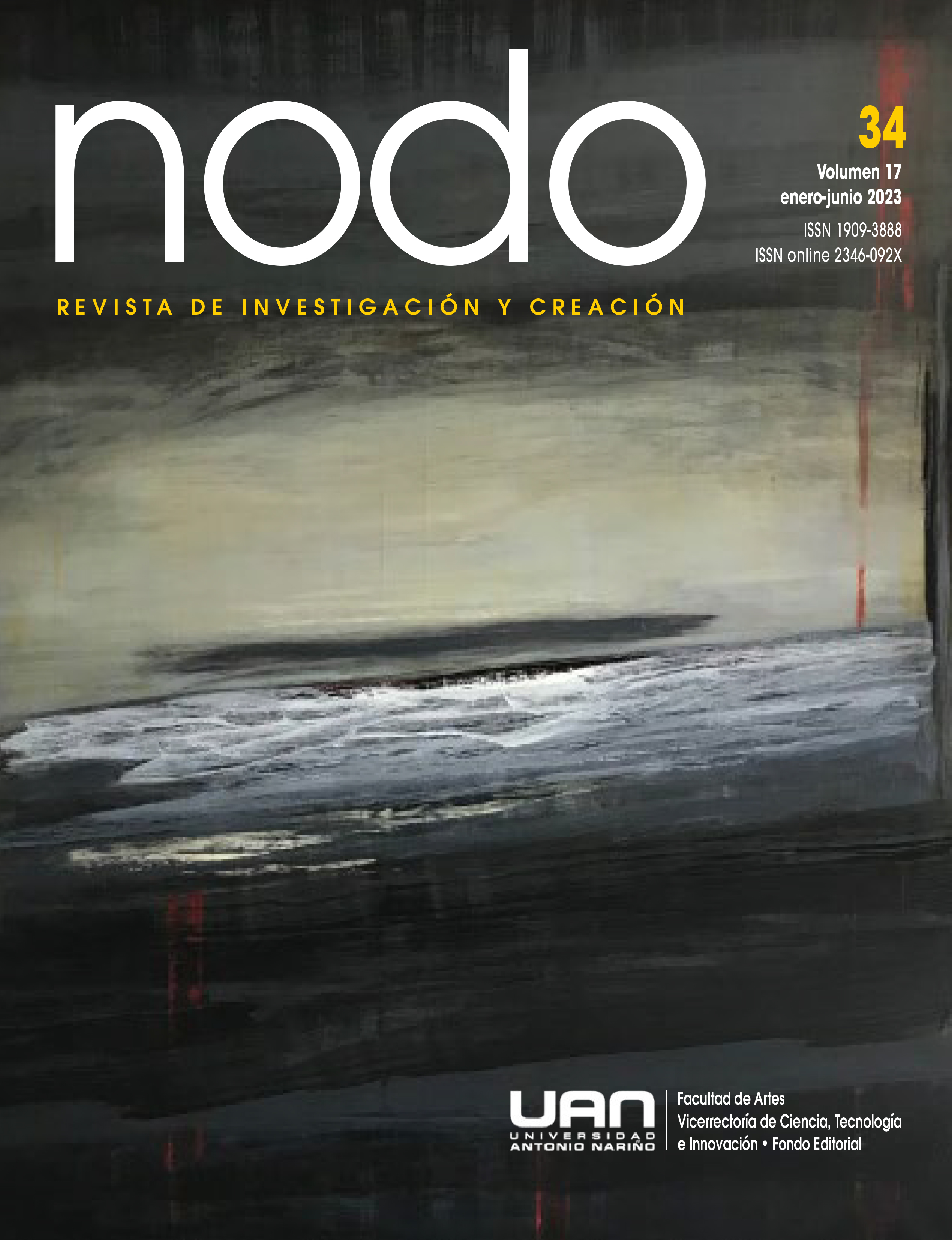Una reinterpretación tímbrica del espacio eco-acústico
A timbral reinterpretation of the echoacoustic space. Guide improvisation through the analysis of the soundscape
DOI:
https://doi.org/10.54104/nodo.v17n34.1267Keywords:
sound-spatial analysis, improvisation, soundscape, musical practicesAbstract
This work exposes a case study that uses the soundscape as an interpretive and analytical guide of space in the context of musical composition and improvisation. The article explores a methodology that allows organizing and interacting space as a compositional element. Different musicians participated in developing an intuitive analysis focused on the perception of space or sound events with moving trajectories. It was possible by using ambisonics technology, which allows it a more accurate appreciation of the acoustic characteristics of the space, as well as different moving acoustic events that occur during the recording. Artists like Barry Truax (Canada, 1947) and David Dunn (United States, 1953), who have included space in their works as an element to interact through sound. Both artists helped us as a reference in developing different strategies to interact with the space, using diverse sounds projected in the space. This methodology developed an approach to study soundscape, as well as showing the results obtained by the different members of the study. All this in order to incorporate the acoustic space as a musical element to study.
Downloads
References
Akiyama, M. (2010). Transparent Listening: Soundscape Composition’s Objects of Study. RACAR: Revue d’art Canadienne / Canadian Art Review, 35(1), 54-62. http://www.jstor.org/stable/42630819
Barrett, N. Spatio-musical composition strategies. Organised Sound, 7, 313-323. doi:10.1017/ S1355771802003114 (2002).
Braasch, J. et al. A Loudspeaker-Based Projection Technique for Spatial Music Applications Using Virtual Microphone Control. Computer Music Journal, 32 (3), 2008, 55-71. JSTOR, www.jstor.org/stable/40072647.
Cage, J. (2010). Cage Silence. Hearing Voices, Agosto de 1992. Transcript of the interview with John Cage in the film Ecoute (Listen) by Miroslav Sebestik. Web publish 3 Feb., hearingvoices.com/2009/09/cage-silence/. (accessed December 4, 2021).
Chion , M. (2015),.Las Tres escuchas. Es lo Cotidiano. November 21. https://www.eslocotidiano.com/articulo/tachas-128/escuchas/20151121102243025093.html
Dunn, D. (1983). Speculations: On the Evolutionary Continuity of Music and Animal Communication Behavior. Perspectives of New Music, 22 (1/2), 87-102. JSTOR, www.jstor.org/stable/832936
Dunn, D. (1988). Wilderness as Reentrant Form: Thoughts on the Future of Electronic Art and Nature. Leonardo, 21 (4), pp. 377-382. JSTOR, www.jstor.org/stable/1578700
Dunn, D., & Lampert, M. (1989). Environment, Consciousness, and Magic: An Interview with David Dunn. Perspectives of New Music, 27(1), 94-105. doi:10.2307/833258
Dunn, D. (2022). David Dunn: Mimus Polyglottos (1976) [Video]. January 03. YouTube. https://www.youtube.com/watch?v=i9veOLaHUzg&feature=youtu.be
Hoose, S. (2015). Creating Immersive Listening Experiences with Binaural Recording Techniques. College Music Symposium, 55. JSTOR, www.jstor.org/stable/26574394
Hron, T. (2014). Useful Scores: Multiple formats for electro acoustic performers to study, rehearse and perform. Organised Sound, 19 (03), diciembre, 239-243. doi: 10.1017/S1355771814000223, Published online: 13 November.
Kendall, G. (2010). Spatial Perception and Cognition in Multichannel Audio for Electroacoustic Music Organised Sound, 15 (03), diciembre, pp 228-238. doi: 10.1017/S1355771810000336, Published online: 25 October 2010.
Krause, B. “Transcript of ‘The Voice of the Natural World.’” TED, May 2014. www.ted.com/talks/bernie_krause_the_voice_of_the_natural_world/transcript#t-156303. (last accessed May 31st 2023).
Pijanowski, B. C., Villanueva-Rivera, L. J., Dumyahn, S. L., Farina, A., Krause, B. L., Napoletano, B. M., Gage, S. H., & Pieretti, N. (2011). Soundscape ecology: The science of sound in the landscape. BioScience, 61(3), 203-216. https://doi.org/10.1525/bio.2011.61.3.6
Truax, B. (1998). Composition and diffusion: space in sound in space. Organised Sound, 3(2), 141-146. https://doi.org/10.1017/s1355771898002076
Truax, B. (2001). Islands. Cambridge Street Publishing, CSR-CD 0101 (Pendlerdrøm). World Soundscape Project. 1997. The Vancouver Soundscape. Cambridge Street Publishing, CSR-2CD 9701
Truax, B. (2008). Soundscape Composition as Global Music: Electroacoustic music as soundscape. Organised Sound, 13(2), 103-109. https://doi.org/10.1017/S1355771808000149
Truax, B. (ed.) (1999). Handbook for Acoustic Ecology. Cambridge Street Publishing, CSR-CDR 9901 (Sound- scape examples).
Downloads
Published
-
Abstract340
-
PDF (Español)51
How to Cite
Issue
Section
License
Copyright (c) 2023 Pablo Rubio Vargas, Jorge Rodrigo Sigal Sefchovich

This work is licensed under a Creative Commons Attribution-NonCommercial-ShareAlike 4.0 International License.




 Portal de Ciencia Abierta
Portal de Ciencia Abierta